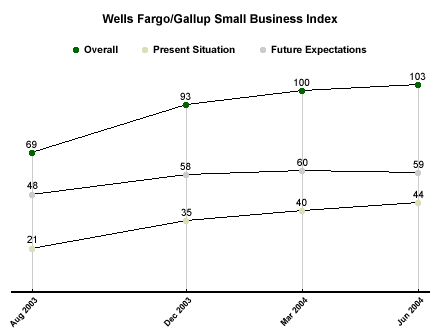Small businesses are known to react more sharply than large businesses do to economic headwinds, and thus they can provide a leading indicator as to where the business cycle is headed. Recent data from the Wells Fargo/Â鶹´«Ã½AV Small Business Index* seem to confirm Fed Chairman Alan Greenspan's July comment that the economy hit a "soft patch" in the second quarter. And components of the Index that measure future expectations show little positive momentum, suggesting that firmer ground may not be right around the corner.
Expectations Fall Flat
The overall Small Business Index -- which measures the present situations of companies with $20 million or less in annual sales -- as well as future expectations of small business owners -- plateaued in June, increasing only marginally from 100 in March to 103. While the Present Situation component of the Index showed an uptick in the second quarter and the Future Expectations component trended slightly downward, neither measure changed significantly.

Healthy Cash Flows and Decreasing Revenues
Â鶹´«Ã½AV asked small business owners for their outlook regarding the company's overall financial situation, as well as their specific expectations for revenues and cash flows 12 months into the future. Owners are upbeat about prospects for their financial situations and cash flows; sentiment on these two aspects has improved steadily since Â鶹´«Ã½AV first asked about them in August 2003.

On the other hand, small business owners are less confident that they will see revenue increases in the next 12 months. Even though 71% of respondents expect cash flows to improve, only 54% are banking on increased revenues. One reason for this discrepancy could be easy credit, with interest rates still at historically low levels. The percentage of small business owners saying it was easy to obtain credit in the last 12 months was the highest it has ever been, and they don't see it becoming more difficult over the next 12 months.

Small business owners' modest revenue expectations are reflected in their plans to maintain resources at current levels. Data from the survey show that over the next year, more small business owners plan to maintain capital expenditures at the same level than did so in March -- 66% plan to keep spending the same (50%) or cut spending (16%). Seventy-nine percent are planning hiring freezes (76%) or staff reductions (3%), up slightly from 71% in March (68% freezes, 3% reductions).


Bottom Line
Small businesses are the main providers of jobs and innovation in the country; according to the U.S. Small Business Administration, more than 99% of employers can be categorized as small businesses, and small businesses produce 13 to 14 times more patents than their larger counterparts do. Given the key role that this sector plays, it's somewhat troubling that there has been no positive movement on the Future Expectations component of the Wells Fargo/Â鶹´«Ã½AV Small Business Index in the second quarter of 2004.
The results raise questions about the Fed's characterization of the recent economic slowdown as a "soft patch": If it's really supposed to blow over quickly, why are small businesses not more optimistic about the future? Why don't they plan to hire more employees over the next 12 months? And why don't they plan on increasing capital expenditures?
*Results for the total dataset are based on telephone interviews with 597 small business owners, conducted June 1-24, 2004. For results based on the total sample of small business owners, one can say with 95% confidence that the margin of sampling error is ±4 percentage points.
